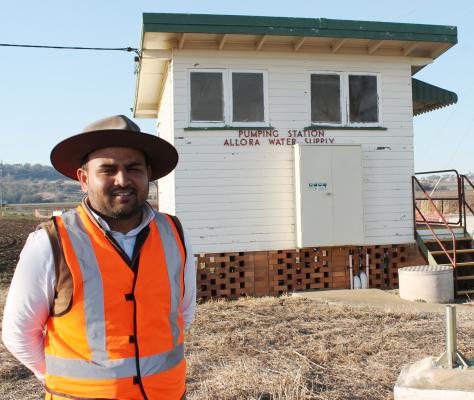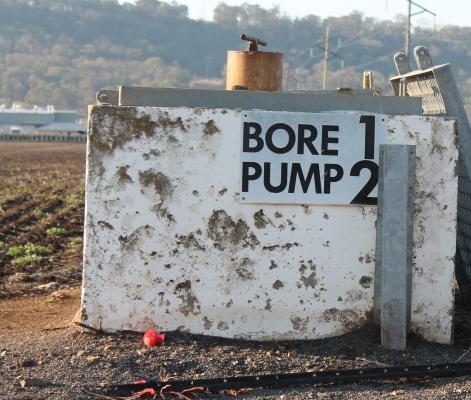By Jeremy Sollars
The Southern Downs Regional Council says the search for alternative water sources for the region is continuing while drought conditions persist, and while we continue to await further updates from the Queensland Government on the proposed Toowoomba to Warwick pipeline first announced back in January.
Substantial rain in February of this year – which now seems like ‘forever’ ago – produced handy inflows into Leslie and Connolly Dams in Warwick. Based on council calculations this means there is a sufficient supply of town water for Warwick, Allora and Yangan and for Stanthorpe for around 30 months, remembering Stanthorpe’s water is being trucked from Connolly Dam.
That’s also based on current household town water restrictions of 120 litres per person per day, and an assumption that drought conditions will persist. It also factors in water for Stanthorpe being taken from Leslie Dam if Connolly were to run dry.
While the February rain eased the immediate pressure on the need to find additional ‘emergency’ water sources, the council is still actively pursuing investigation of the region’s underground or bore water supplies. These are more or less confined to the Warwick and surrounding districts – due to the topography of the Granite Belt underground water sources for Stanthorpe are far more limited.
Using bore water for town water supply also has a few issues. The bores need to be located on public land – either council, State Government or crown – and bore water needs to be pumped up to the surface and then pumped further to water treatment plants.
In many cases bore water will also require significant treatment to bring it up to drinking standard – bore water can contain a wide variety of naturally-occurring elements which in ‘raw’ untreated form can render it unsuitable for drinking, from both a health and taste perspective.
To date the council says the most ‘viable’ source of bore water it has identified are the ‘old’ Allora bores. A town water pipeline connecting Allora to the Warwick treated supply was completed in 2014 – prior to that three bores located on Bradfields Road just south of Allora were its water source.
Since the town water pipeline went in those bores have sat ‘dormant’, but the council says their testing has found the bores could ‘yield’ up to one megalitre (ML) of water per day. To put that in some perspective, Stanthorpe as a town requires about 1.3ML per day to meet its household usage needs.
While ‘a meg a day’ is a pretty good output, for the Allora bores to be useable as an ‘emergency’ drinking water source in extreme drought conditions the bores themselves would need to be ‘re-commissioned’ with new pipes and pumps, and the water itself would most likely be treated at the existing reservoir, a few kilometres to the north next to the Allora waste facility. Allora’s bore water is ‘hard’ water, meaning it contains high amounts of natural mineral elements so as well as purification it would also need ‘softening’. To treat it to drinking standard would require the installation of a small treatment plant at the reservoir – pumping and treatment is not insurmountable, but it would come at a cost.
Treated water from the Allora bores could then be used both to supply Allora itself and the remainder sent back down the existing town pipeline to Warwick to supplement the Warwick supply.
The council’s Manager of Water Lalji Rathod says while current dam levels mean the search for emergency water supplies has “changed to some extent, work on supplementary water is ongoing”.
In the current financial year the council has budgeted nearly $172,000 for “bore investigation and rejuvenation” and while Allora looks the most promising location so far for underground supplies, Lalji Rathod says the council continues to investigate other sites in the Warwick and Allora areas, “in the Dalrymple Creek and Condamine River alluviums”, or floodplains.
“The need for supplementary water is not as pressing as it was at the start of this year, but we are continuing with that work,” Lalji told the Free Times this week.
“The main issue with bore water will always be quality and treating it to a suitable standard,” he said.
“You also want bores to be close to existing water infrastructure wherever possible for ease of transfer and treatment.
“So far council has assessed nine potential bore sites, at Allora and at Pratten, Yangan and Wallangarra.
“So far Allora is showing as the most viable location, but we’re also confident the bore supply at Wallangarra could come online to supplement Beehive Dam and The Soak if it needed to.
“What we’re now doing is looking to pinpoint other potential sites close to Warwick, within the Condamine alluvium catchment.
“Ongoing if any of those locations, where there’s an existing extraction licence on public land, look to be viable then we’ll look at drilling and potential further assessment.
“At this stage we hope to be able to report further on those investigations around the end of August.”
(SUBHEAD)
Dam levels, as of this week…
Leslie Dam (Warwick) – 13,653ML (12.85%)
Connolly Dam (Warwick – currently used to supply Stanthorpe) – 1837ML (84.8%)
Storm King Dam (Stanthorpe – currently offline) – 362ML (17.5%)
(SUBHEAD)
Pipeline silence…
The Queensland Government is yet to announce the results of a feasibility study into a potential water pipeline from Toowoomba to Warwick, which would allow the Southern Downs Regional Council to access water from Wivenhoe Dam in Brisbane, via the existing Wivenhoe-Toowoomba pipeline. Such a supply would be an ongoing emergency water source for the Warwick and Stanthorpe regions.
Premier Annastacia Palaszczuk announced in January of this year that Seqwater would undertake a feasibility and costings study on the project but no further announcements have been made to date. The Free Times is regularly checking with the Premier’s office to see when an update may be forthcoming…








